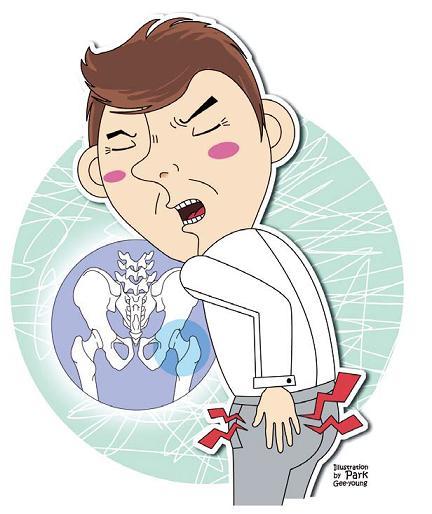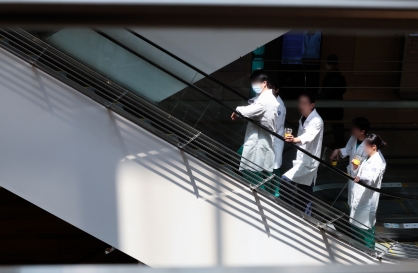The hip is the joint that connects the pelvis to the leg. Pelvic disease often occurs in this joint, which supports much of the body’s weight and has a structure commonly described as a ball and socket. When walking, the joint can be placed under 3-4 times more pressure than caused by body weight, and when running, this pressure can be 10 times more.
Pelvic disease can occur after the middle-aged years.
Fractures
For younger people, fractures around the joint are usually caused by serious accidents, such as a car crash or a fall. But in older people they can be caused by minor trauma, such as slipping over or falling from the bed, due to weakened bones from osteoporosis.
Osteoporosis, or weakening of the bones, is sometimes called the “silent thief,” as it is often not picked up until there is a fracture. Once there is a fracture, it is difficult to operate on.

In osteoporosis, bones that should normally be hard weaken due to a decrease in bone mass and the destruction of its internal structure. It occurs mostly in women over 60, especially those who have thin bones and a light body weight.
A fracture to the femur from osteoporosis usually requires surgery, but in most cases, it is difficult to carry out because of the inadequate bone mass. Hence, this type of fracture results in a high mortality rate ― 1 in 4 people dies. In addition, if osteoporosis is not prevented at an early stage, patients can suffer severe backache for life because of the stooped lower back and reduced height of the spine collapses due to a compression fracture.
As well as aging and a low body mass, risk factors for osteoporosis include limited exercise, problems with eating, and genetic factors, as well as a lack of female hormones after menopause.
Ways to help prevent osteoporosis include:
● Exercise therapy: Weight-bearing exercise that strengthens the muscles and the bones such as fast walking and jogging are recommended.
● Dietary therapy: Sufficient intake of calcium (food such as milk, yogurt, anchovies, mackerel, shrimp and beans).
● Pharmacological therapy: Doses of calcium and vitamin D hormone therapy (exposure to sunlight, drug consumption).
Avascular necrosis of the femoral head
The head of the femur is relatively small. This means the head of the femur gets much less blood circulation than other areas of the body, due to the limited number and size of the blood vessels. Because of this, when the blood flow to this area is interrupted, necrosis of the head of the femur may occur.
This illness is called the avascular necrosis of the femoral head. In most countries in Asia, including Korea, more than 70 percent of pelvic disease is made up of the avascular necrosis of the femoral head. Every year in Korea, more than 4,000 patients suffer from this illness.
The initial symptom of this illness is pain around the hip joint. This pain is often found in the buttocks, thigh and sometimes around the knees. The pain worsens through movement.
Drinking alcohol for a long period of time, taking too many steroids (for dermatitis, arthritis, neurological disorders, allergic disease and kidney transplants) and taking Chinese herbal medicine can all cause this illness.
Arthritis in the hip
Past injuries, incomplete growth of the pelvis, suppurative arthritis or tubercular arthritis suffered while young, and avascular necrosis of the hip are among the causes of arthritis in the hip.
Typically, there are no symptoms before adulthood, but sufferers feel pain and hobble from worsened arthritis after entering middle age.
The treatment varies depending on the degree; hence, an examination by a specialist is required, to prescribe treatment with drugs, bone fracture surgery, a hip replacement surgery or other treatment.
Hip replacements substitute the damaged joint with an insertion that does almost no harm to the human body. This surgery is a groundbreaking field in the orthopedics, and every year in the United States, approximately 300,000 people undergo this surgery.
It is used in cases where severe arthritis causes severe pain and medication does not help, and for avascular necrosis or sometimes fractures around the hip joint.
The surgery lasts for approximately 1.5 hours, and the patient may be discharged from the hospital 7-10 days after surgery.
Crutches or a walker may be used to assist walking and to access the toilets, depending on progress after the surgery. Crutches will need to be used for approximately two months after the surgery.
New materials are being developed to increase the life span of artificial hip joints, but the average life of a hip joint is 15-20 years. Young people are more active, so they may need repeat surgery.
By Park Youn-soo
The author is a doctor at the Department of Orthopedics at Samsung Medical Center and a professor of Sungkyunkwan University School of Medicine. ― Ed.
Pelvic disease can occur after the middle-aged years.
Fractures
For younger people, fractures around the joint are usually caused by serious accidents, such as a car crash or a fall. But in older people they can be caused by minor trauma, such as slipping over or falling from the bed, due to weakened bones from osteoporosis.
Osteoporosis, or weakening of the bones, is sometimes called the “silent thief,” as it is often not picked up until there is a fracture. Once there is a fracture, it is difficult to operate on.

In osteoporosis, bones that should normally be hard weaken due to a decrease in bone mass and the destruction of its internal structure. It occurs mostly in women over 60, especially those who have thin bones and a light body weight.
A fracture to the femur from osteoporosis usually requires surgery, but in most cases, it is difficult to carry out because of the inadequate bone mass. Hence, this type of fracture results in a high mortality rate ― 1 in 4 people dies. In addition, if osteoporosis is not prevented at an early stage, patients can suffer severe backache for life because of the stooped lower back and reduced height of the spine collapses due to a compression fracture.
As well as aging and a low body mass, risk factors for osteoporosis include limited exercise, problems with eating, and genetic factors, as well as a lack of female hormones after menopause.
Ways to help prevent osteoporosis include:
● Exercise therapy: Weight-bearing exercise that strengthens the muscles and the bones such as fast walking and jogging are recommended.
● Dietary therapy: Sufficient intake of calcium (food such as milk, yogurt, anchovies, mackerel, shrimp and beans).
● Pharmacological therapy: Doses of calcium and vitamin D hormone therapy (exposure to sunlight, drug consumption).
Avascular necrosis of the femoral head
The head of the femur is relatively small. This means the head of the femur gets much less blood circulation than other areas of the body, due to the limited number and size of the blood vessels. Because of this, when the blood flow to this area is interrupted, necrosis of the head of the femur may occur.
This illness is called the avascular necrosis of the femoral head. In most countries in Asia, including Korea, more than 70 percent of pelvic disease is made up of the avascular necrosis of the femoral head. Every year in Korea, more than 4,000 patients suffer from this illness.
The initial symptom of this illness is pain around the hip joint. This pain is often found in the buttocks, thigh and sometimes around the knees. The pain worsens through movement.
Drinking alcohol for a long period of time, taking too many steroids (for dermatitis, arthritis, neurological disorders, allergic disease and kidney transplants) and taking Chinese herbal medicine can all cause this illness.
Arthritis in the hip
Past injuries, incomplete growth of the pelvis, suppurative arthritis or tubercular arthritis suffered while young, and avascular necrosis of the hip are among the causes of arthritis in the hip.
Typically, there are no symptoms before adulthood, but sufferers feel pain and hobble from worsened arthritis after entering middle age.
The treatment varies depending on the degree; hence, an examination by a specialist is required, to prescribe treatment with drugs, bone fracture surgery, a hip replacement surgery or other treatment.
Hip replacements substitute the damaged joint with an insertion that does almost no harm to the human body. This surgery is a groundbreaking field in the orthopedics, and every year in the United States, approximately 300,000 people undergo this surgery.
It is used in cases where severe arthritis causes severe pain and medication does not help, and for avascular necrosis or sometimes fractures around the hip joint.
The surgery lasts for approximately 1.5 hours, and the patient may be discharged from the hospital 7-10 days after surgery.
Crutches or a walker may be used to assist walking and to access the toilets, depending on progress after the surgery. Crutches will need to be used for approximately two months after the surgery.
New materials are being developed to increase the life span of artificial hip joints, but the average life of a hip joint is 15-20 years. Young people are more active, so they may need repeat surgery.
By Park Youn-soo
The author is a doctor at the Department of Orthopedics at Samsung Medical Center and a professor of Sungkyunkwan University School of Medicine. ― Ed.
-
Articles by Korea Herald





![[Weekender] Korean psyche untangled: Musok](http://res.heraldm.com/phpwas/restmb_idxmake.php?idx=644&simg=/content/image/2024/05/02/20240502050841_0.jpg&u=)



![[Eye Interview] 'If you live to 100, you might as well be happy,' says 88-year-old bestselling essayist](http://res.heraldm.com/phpwas/restmb_idxmake.php?idx=644&simg=/content/image/2024/05/03/20240503050674_0.jpg&u=)








![[Herald Interview] Director of 'Goodbye Earth' aimed to ask how we would face apocalypse](http://res.heraldm.com/phpwas/restmb_idxmake.php?idx=652&simg=/content/image/2024/05/03/20240503050732_0.jpg&u=)
